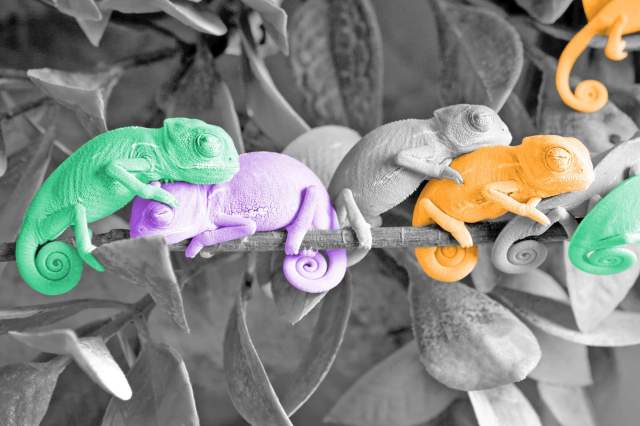
Chameleons Change Color Thanks to Special Skin Cells
The chameleon’s famed superpower comes courtesy of special skin cells called iridophores. These cells contain complex lattices of nanocrystals, which reflect different wavelengths of light as they expand and contract. As such, color changes are often affected by a chameleon’s mood; when agitated by a rival, for example, a male’s skin cells will stretch and reflect longer wavelengths of light such as yellow, orange, or red. Furthermore, because these animals can’t generate their own body heat, they become darker or lighter to absorb or reflect sunlight as needed. Contrary to popular belief, chameleons do not change color to blend in with their surroundings.

Chameleons Range From Less Than 1 Inch to More Than 2 Feet
Most chameleons grow to a length of 7 to 10 inches, but there are extremes on both ends of the size spectrum. The 1.5-pound Parson’s chameleon is the heaviest species by weight, while its length of 26 to 27 inches is matched by the Malagasy giant chameleon. The recently discovered nano-chameleon (Brookesia nana), on the other hand, sports a body length of just over a half-inch and a total length of less than nine-tenths of an inch, making it the smallest known reptile on the planet.

Chameleon Tongues Are Among the Fastest in the Animal Kingdom
While the animals themselves might be slow-moving, that adjective doesn’t apply to the chameleon’s tongue, which propels from its mouth at a peak acceleration of 264 times the force of gravity (the equivalent of going zero to 60 mph in one-hundredth of a second). These organs reach super speed thanks to a spring-loaded accelerator muscle and spirally wound protein fibers that work “sort of like a telescopic catapult,” in the words of one researcher. And thanks to a slathering of mucus that’s 400 times more viscous than human saliva, these powerful tongues can easily latch onto and reel in an insect or small animal of up to 30% of the chameleon’s body weight.
More Interesting Reads

Chameleons Have Incredible Vision
Another distinct feature of these animals: those domed, swiveling eyes. Protected by conical lids that leave only a small opening for the pupil, chameleon eyes are capable of nearly 360 degrees of panoramic views as they alternate between monocular and binocular vision. Although scientists previously believed that chameleon eyes acted independently of one another, recent research indicates that each eye keeps track of the other’s activities even when seemingly focused elsewhere. And what chameleons see would dazzle human minds: They combine a nearsighted lens with a farsighted cornea to work like a telephoto lens, while also possessing the ability to detect ultraviolet light.

Some Chameleons Glow Under UV Light
If specialized skin cells, eyes, and tongues aren’t enough to inspire a favorable impression of these creatures, how about bones that glow in the dark? This discovery came courtesy of a team of German researchers, who detailed in a 2018 paper how these lizards sport rows of bony protuberances close enough to the skin to produce conspicuous glowing beneath UV lighting. It’s unclear what evolutionary processes drove this trait, as not all chameleons display visible fluorescence. However, because the glowing is more readily apparent among species that live in low-visibility rainforests, researchers have proposed that it aids with communication and sexual selection.

Chameleon Toes Are Bundled Into Two Groups
While they possess five digits per foot like most lizards, chameleons are distinguished by their zygodactylous feet, in which the toes are fused into opposing bundles of two and three. This feature, which develops in the embryonic stage, provides these animals with a sturdy grip when clinging to trees. Furthermore, chameleons have been found to possess hairlike “friction-enhancing” growths on their feet; while these bristles lack the adhesive properties of similar growths on geckos, they nevertheless provide additional support for climbing and grabbing.

Most Chameleons Have Prehensile Tails
Most chameleon species receive another climbing assist from a prehensile tail, an appendage strong enough to keep an individual tethered to a tree while it releases its feet to reach for a branch. However, the benefit these tails provide to arboreal chameleons is offset by their lack of expendability in battle; while many other lizards can self-amputate a tail in the grip of a predator and later grow it back, a chameleon can do neither. Owners will notice that their pets sometimes keep their tails curled up in a ball, an act that could reflect a need to keep balanced on a perch, or a range of emotions from anxiety to contentment.

Chameleon Eggs Can Take Up to Two Years to Incubate
Although some chameleons give birth to live young, most females of the extended family lay eggs in a clutch that can number two to four for smaller species and 80 to 100 for large ones. Incubation periods also widely vary; some eggs hatch after four months, while those of the massive Parson’s chameleon can take around two years. While baby Labord’s chameleons emerge from their shells after nine months, these animals survive for only about four months afterward, which means the adult population is already gone by the time the next generation of hatchlings enter the world.

As Many as One-Half of All Species Face Threats to Survival
Native to areas of southern Europe, western Asia, and especially Africa (nearly half of the 200-plus identified species are found only on the island of Madagascar), chameleons occupy a wide range of habitats across deserts, rainforests, grasslands, and mountains. However, these slow-moving animals are range-restricted, which leaves them vulnerable to destructive human activities such as slash-and-burn farming. As a result, approximately one-third to one-half of all chameleon species face a troubling classification status of threatened or near-threatened.












